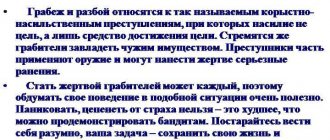MIP online legal encyclopedia - » Criminal cases - comments of a Federal Judge / MIP Law Group » General provisions of the Criminal Code of the Russian Federation - comments of a Federal Judge / MIP Law Group » Preparation for a crime and attempted crime. Lawyer's comment
Sign up for a consultation with the head of the criminal department. Professional explanations. Unlimited consultation time
Preparation for a crime and attempted crime - free answers from lawyers online
The concept and types of stages of committing a crime
Committing a crime is a process consisting of several stages:
- preparation for a crime;
- attempted crime;
- finished composition.
The significance of the stages of committing crimes is of particular importance since the formation and detection of intent is not punishable by law, but subsequent stages of implementation entail criminal liability. Each of the above stages is criminally punishable, however, there are nuances in qualifying the actions of the criminal, depending on the specific stage.
Types of assassination attempts
A crime that is not completed may have its own characteristics and a number of unforeseen circumstances that prevent the criminal from achieving his goal.
The practice and theory of criminal law know the following types of attempted crimes:
- finished;
- unfinished;
- worthless.
Depending on the completeness of the implementation of the objective side, completed and unfinished attempts are distinguished. When an attempt is completed, the person commits all those actions that are necessary to bring the crime to the desired end, but the crime is not completed due to circumstances beyond his control. As for an unfinished attempt, the person does not have time to complete all those actions that are necessary to complete the crime. An unfinished attempt is also called “interrupted.”
If the attempt is completed, voluntary refusal to complete the work begun is impossible, and if the attempt is unfinished, refusal to carry out the criminal plan is possible at any stage of the crime.
There is a third type of attempt - on an unsuitable object or by unsuitable means. An attempt to commit a crime using unsuitable means implies a situation in which, in the course of committing a crime, the perpetrator uses an unsuitable weapon. That is, means the use of which cannot lead to a criminal result.
This is a kind of factual mistake by the subject of the crime himself. An example would be trying to kill a person with a faulty weapon. An attempt on an unusable object refers to cases when a person encroaches on an object that does not fall under criminal legal protection. For example, opening an empty safe or shooting a corpse.
Although in both cases socially dangerous consequences do not occur, and often there are not even victims, the perpetrator bears responsibility on a general basis under Article 30 of the Criminal Code.
Preparation for a crime of the Criminal Code of the Russian Federation
The Criminal Code of the Russian Federation in its general provisions contains a norm that defines the concept of one of the stages of a crime - preparation for it. According to this norm, these are absolutely all actions of an intentional nature that are aimed at creating conditions for the implementation of the objective side of the tort.
An exhaustive list of such actions is not contained either in the Criminal Code of the Russian Federation itself or in other legal acts. However, the general provisions list the main characteristic features of the stage of preparation for committing a criminal act:
- finding means or instruments for the implementation of a tort. The methods of acquisition do not play a role; it can be either a purchase, or making it yourself, or taking possession of it as a result of theft, etc. A weapon can be any material object used for illegal purposes. The means of crime are objects that facilitate the implementation of criminal intent, while they cannot simultaneously act as a weapon. For example, a master key, a vehicle, etc. At the same time, the same object, depending on the type of attack, can be used as a weapon or as a means. For example, in a murder, a vehicle can act as a weapon when a person intentionally hits another person, or in a theft, a vehicle facilitates the transportation of material assets by the stolen person.
- finding accomplices of illegal actions. Can be carried out through selection, recruitment, training, etc. Any active actions of a criminal to involve other persons in criminal activities.
- collusion. Reaching agreements between accomplices in a crime on the time, place, method and other nuances of committing a criminal attack on public relations protected by the Criminal Code of the Russian Federation.
Individual preparatory actions are already regarded by the Criminal Code of the Russian Federation as an independent completed crime. In this case, the final actions of the criminal are subject to qualification according to the totality of crimes. Preparation for a crime occurs if at least one of the above signs is established.
Need help from a criminal lawyer?
Help from a specialist with 20 years of experience!
+7
Concept, signs and types of attempted crime, responsibility
Article 30. Preparation for a crime and attempted crime
1. Preparation for a crime is the search, manufacture or adaptation by a person of means or instruments for committing a crime, the search for accomplices to a crime, conspiracy to commit a crime or other deliberate creation of conditions for the commission of a crime, if the crime was not completed due to reasons beyond the control of this person. circumstances.
2. Criminal liability arises for preparation only for grave and especially grave crimes.
3. An attempted crime is the intentional actions (inaction) of a person directly aimed at committing a crime, if the crime was not completed due to circumstances beyond the control of this person.
In accordance with Part 3 of Art. 30 of the Criminal Code “ an attempted crime is the intentional actions (inaction) of a person directly aimed at committing a crime, if the crime was not completed due to circumstances beyond the control of this person.” This definition of attempt reflects the essence and specificity of the institution of attempt.
Objective signs of an attempt should include:
a) the direct focus of the action on committing a crime;
b) incompleteness of the attack due to circumstances beyond the control of the perpetrator;
c) its incompleteness.
A subjective sign of an attempt is the intentional nature of the actions. Attempt as a deliberate act directly aimed at committing a crime should be understood as the commission of actions included in the objective side of the crime.
This is the first objective sign of an attempt; during an attempt, actions always take place that directly fulfill the corpus delicti of this crime. A characteristic feature of an attempt, which distinguishes it from preparation, is that during an attempt the object of the crime is placed under the immediate threat of harm. During an attempt, actions included in the objective side of the crime have already been committed.
But with an attempt, unlike a completed crime, some signs of the objective side of the crime are missing: the criminal result,
specified in the relevant article of the Special Part of the Criminal Code, or
the complete completion of all actions
that form the objective side of the crime.
Failure to complete the crime constitutes the second objective sign of an attempt.
It is the incompleteness of the crime that distinguishes an attempt from a completed crime and is one of the grounds for separating an attempt into an independent stage.
However, incompleteness in an attempt should not always be understood as incompleteness of the actual actions of the perpetrator, although this sign does occur.
Usually, during an assassination attempt, the person does not have time to complete all the actions that he intended to perform. For example, in an attempted murder, the actions of the perpetrator are often stopped by the intervention of other citizens. The incompleteness of the crime during an attempt means that the crime is not completed, although in fact the actions of the perpetrator may be completed. Thus, when the attempt is completed, the perpetrator is convinced that he has done everything necessary to commit the crime, believes that the crime is completed, and therefore stops his socially dangerous actions.
So, incompleteness in an attempt should be understood, first of all, as the absence of all objective signs of the crime provided for by this norm of the Special Part of the Criminal Code.
It should be borne in mind that when an assassination attempt occurs, certain socially dangerous consequences often occur, but other than those that the perpetrator sought to cause. For example, when attempted murder occurs, personal injury is often caused. However, this circumstance does not turn the crime into a completed crime, since in order to recognize the crime as completed, not any harmful consequences must occur, but only those that are directly specified in the law.
The incompleteness of actions in an attempted crime is characterized, as already noted, by the non-occurrence of the criminal result specified in the law. This circumstance is typical for crimes with a material composition; incompleteness in an attempt means incomplete
performance by the offender of actions prohibited by law.
At the same time, in cases where the criminal result provided for by law does not occur immediately, but after some time (for example, death occurs some period after the stabbing with the intent to kill), the crime should be considered completed. Criminal legislation does not know the so-called critical periods for the development of a causal relationship between
action and consequence.
The criminal law recognizes a crime as completed if the criminal result (of the intentional actions of the perpetrator) occurs regardless of how much time has passed after the perpetrator committed socially dangerous actions.
The third objective sign of an attempt is the failure to complete the crime for reasons beyond the will of the perpetrator.
The legislative definition of attempt contains an important indication that an attempted crime is an intentional act. This emphasizes the main subjective feature of the assassination attempt. Attempted crime is characteristic only of deliberate criminal activity. There can be no attempt, as well as preparation, when a crime is committed through negligence. A person attempting to commit a crime and seeking to achieve its completion cannot act recklessly. In these cases, we can only talk about the intent of the person.
If the subject does not want to commit a crime, therefore, he cannot attempt to commit it.
An attempt, as well as preparation, is possible only if there is direct intent .
With indirect intent, the person does not want the criminal result to occur, does not strive to complete the crime, and therefore cannot prepare for it or attempt to commit it. A criminal result for a person with indirect intent is one of the possible consequences of his actions, and the subject is passive towards its occurrence.
The Plenum of the Supreme Court of the Russian Federation, giving explanations to the courts on the resolution of a number of categories of criminal cases, also repeatedly emphasized in its decisions that an attempt to commit a crime can only be committed with direct intent.
Thus, the Plenum of the Supreme Court of the Russian Federation in paragraph 2 of the resolution of January 27, 1999 No. 1 “On judicial practice in murder cases (Article 105 of the Criminal Code)” indicated that attempted murder is possible only with direct intent, i.e. when the act indicated that the perpetrator was aware of the social danger of his
actions (inaction), foresaw the possibility or inevitability of the death of another person and wanted it to occur, but the death did not occur due to circumstances beyond his control (due to the active resistance of the victim, the intervention of other persons, timely provision of medical care to the victim, etc.)
In criminal law, attempts are usually divided into two main types - completed and unfinished .
To divide an attempt into types, one should use a subjective criterion, i.e. be guided by the subject’s own idea of the degree of completion of the crime.
A completed attempt is one in which the subject did everything that he considered necessary to commit the crime, but this crime was not completed due to circumstances beyond his control.
An unfinished attempt is one in which the subject has not yet committed everything that he considered necessary to commit the crime.
(However, a number of authors believe that when dividing an attempt into types, one should use an objective
Criterion.
Speaking against supporters of the second point of view, N.D. Durmanov quite rightly emphasized that “the adoption of an objective criterion for distinguishing between a completed and an unfinished attempt would lead to endless scholastic disputes about whether the actions actually committed by the perpetrator were or were not necessary to commit the crime.”
There are also supporters of a mixed criterion: when dividing an attempt into types, it is recommended to use subjective and objective criteria simultaneously.
If the criminal result did not occur, it means that not everything that was necessary for the criminal result to occur was done. Applying an objective criterion for dividing an attempt into types, it will be necessary to recognize the existence of a completed attempt as impossible, because some actions of the perpetrator will always be insufficient to complete the crime. To deny the existence of a completed attempt means not to take into account the great importance of the attitude of the guilty person to the actions he committed. And this is necessary both to establish the guilt of the subject and to determine the degree of public danger of committing a crime, which is reflected, in particular, when assigning punishment.)
Completed assassination attempt,
ceteris paribus, is usually more dangerous than unfinished. It is often accompanied by the infliction of certain harm, especially in the case of attempted murder, although this harm is not the criminal result that the perpetrator sought. A completed attempt is closer in its characteristics to a completed crime. However, a clear boundary should always be drawn between them. This distinction is made on the objective side of the crime. In a completed attempt, in contrast to a completed crime, the criminal result that the perpetrator was striving for is always missing, or all the actions that he intended to perform to fulfill his criminal intention have not been completed.
The division of an attempt into completed and unfinished has a certain theoretical and practical significance. Although the current criminal legislation does not use the terms “completed” and “unfinished” attempt, the degree of implementation of the criminal intention should be taken into account along with other circumstances. This requirement is taken into account when dividing an attempt into completed and unfinished.
In addition, the division of attempt into types is of great importance in cases where the question arises about the presence or absence of voluntary refusal.
In legal literature, it is also customary to distinguish an unworthy attempt .
An unsuitable attempt, in turn, is divided into
an attempt on an unsuitable object
and
an attempt with unsuitable means .
An attempt on an unfit object is usually understood as those cases when the culprit encroaches on a certain object, but his actions, due to an error he makes, do not create a real danger of causing harm to the object.
It should be noted that the expression “attempt on a worthless object”
obviously unsuccessful.
Object, i.e. the social relations
that the perpetrator encroaches on
cannot be worthless.
The objects of the attack
may be unusable due to the lack of properties that the perpetrator expected.
If the culprit, for example, stole a weapon (ammunition supplies, explosives) that was unsuitable for functional use, being mistaken about its quality and believing that it was in good working order, the act should be qualified as an attempted theft of a weapon (ammunition supplies, explosives, explosive devices)[16 ].
An attempt with unsuitable means is usually understood as such cases when the perpetrator, in order to achieve his goals, uses means that, objectively, due to their properties, cannot lead to the completion of the crime or to the occurrence of a criminal result.
Typically, an attempt on an unsuitable object, as well as an attempt with unsuitable means, has signs of social danger, and the person who committed such an attempt is subject to criminal liability on a general basis. The perpetrator in these cases has the intention to commit a certain socially dangerous act provided for by criminal law, and the crime is not completed due to circumstances beyond the control of the person.
Article 66. Imposition of punishment for an unfinished crime
1. When assigning punishment for an unfinished crime, the circumstances due to which the crime was not completed are taken into account.
2. The term or amount of punishment for preparation for a crime cannot exceed half the maximum term or amount of the most severe type of punishment provided for by the relevant article of the Special Part of this Code for the completed crime.
3. The term or amount of punishment for an attempted crime cannot exceed three quarters of the maximum term or amount of the most severe type of punishment provided for by the relevant article of the Special Part of this Code for the completed crime.
4. The death penalty and life imprisonment for preparation for a crime and attempted crime are not imposed.
Article 30. Preparation for a crime and attempted crime
1. Preparation for a crime is the search, manufacture or adaptation by a person of means or instruments for committing a crime, the search for accomplices to a crime, conspiracy to commit a crime or other deliberate creation of conditions for the commission of a crime, if the crime was not completed due to reasons beyond the control of this person. circumstances.
2. Criminal liability arises for preparation only for grave and especially grave crimes.
3. An attempted crime is the intentional actions (inaction) of a person directly aimed at committing a crime, if the crime was not completed due to circumstances beyond the control of this person.
In accordance with Part 3 of Art. 30 of the Criminal Code “ an attempted crime is the intentional actions (inaction) of a person directly aimed at committing a crime, if the crime was not completed due to circumstances beyond the control of this person.” This definition of attempt reflects the essence and specificity of the institution of attempt.
Objective signs of an attempt should include:
a) the direct focus of the action on committing a crime;
b) incompleteness of the attack due to circumstances beyond the control of the perpetrator;
c) its incompleteness.
A subjective sign of an attempt is the intentional nature of the actions. Attempt as a deliberate act directly aimed at committing a crime should be understood as the commission of actions included in the objective side of the crime.
This is the first objective sign of an attempt; during an attempt, actions always take place that directly fulfill the corpus delicti of this crime. A characteristic feature of an attempt, which distinguishes it from preparation, is that during an attempt the object of the crime is placed under the immediate threat of harm. During an attempt, actions included in the objective side of the crime have already been committed.
But with an attempt, unlike a completed crime, some signs of the objective side of the crime are missing: the criminal result,
specified in the relevant article of the Special Part of the Criminal Code, or
the complete completion of all actions
that form the objective side of the crime.
Failure to complete the crime constitutes the second objective sign of an attempt.
It is the incompleteness of the crime that distinguishes an attempt from a completed crime and is one of the grounds for separating an attempt into an independent stage.
However, incompleteness in an attempt should not always be understood as incompleteness of the actual actions of the perpetrator, although this sign does occur.
Usually, during an assassination attempt, the person does not have time to complete all the actions that he intended to perform. For example, in an attempted murder, the actions of the perpetrator are often stopped by the intervention of other citizens. The incompleteness of the crime during an attempt means that the crime is not completed, although in fact the actions of the perpetrator may be completed. Thus, when the attempt is completed, the perpetrator is convinced that he has done everything necessary to commit the crime, believes that the crime is completed, and therefore stops his socially dangerous actions.
So, incompleteness in an attempt should be understood, first of all, as the absence of all objective signs of the crime provided for by this norm of the Special Part of the Criminal Code.
It should be borne in mind that when an assassination attempt occurs, certain socially dangerous consequences often occur, but other than those that the perpetrator sought to cause. For example, when attempted murder occurs, personal injury is often caused. However, this circumstance does not turn the crime into a completed crime, since in order to recognize the crime as completed, not any harmful consequences must occur, but only those that are directly specified in the law.
The incompleteness of actions in an attempted crime is characterized, as already noted, by the non-occurrence of the criminal result specified in the law. This circumstance is typical for crimes with a material composition; incompleteness in an attempt means incomplete
performance by the offender of actions prohibited by law.
At the same time, in cases where the criminal result provided for by law does not occur immediately, but after some time (for example, death occurs some period after the stabbing with the intent to kill), the crime should be considered completed. Criminal legislation does not know the so-called critical periods for the development of a causal relationship between
action and consequence.
The criminal law recognizes a crime as completed if the criminal result (of the intentional actions of the perpetrator) occurs regardless of how much time has passed after the perpetrator committed socially dangerous actions.
The third objective sign of an attempt is the failure to complete the crime for reasons beyond the will of the perpetrator.
The legislative definition of attempt contains an important indication that an attempted crime is an intentional act. This emphasizes the main subjective feature of the assassination attempt. Attempted crime is characteristic only of deliberate criminal activity. There can be no attempt, as well as preparation, when a crime is committed through negligence. A person attempting to commit a crime and seeking to achieve its completion cannot act recklessly. In these cases, we can only talk about the intent of the person.
If the subject does not want to commit a crime, therefore, he cannot attempt to commit it.
An attempt, as well as preparation, is possible only if there is direct intent .
With indirect intent, the person does not want the criminal result to occur, does not strive to complete the crime, and therefore cannot prepare for it or attempt to commit it. A criminal result for a person with indirect intent is one of the possible consequences of his actions, and the subject is passive towards its occurrence.
The Plenum of the Supreme Court of the Russian Federation, giving explanations to the courts on the resolution of a number of categories of criminal cases, also repeatedly emphasized in its decisions that an attempt to commit a crime can only be committed with direct intent.
Thus, the Plenum of the Supreme Court of the Russian Federation in paragraph 2 of the resolution of January 27, 1999 No. 1 “On judicial practice in murder cases (Article 105 of the Criminal Code)” indicated that attempted murder is possible only with direct intent, i.e. when the act indicated that the perpetrator was aware of the social danger of his
actions (inaction), foresaw the possibility or inevitability of the death of another person and wanted it to occur, but the death did not occur due to circumstances beyond his control (due to the active resistance of the victim, the intervention of other persons, timely provision of medical care to the victim, etc.)
In criminal law, attempts are usually divided into two main types - completed and unfinished .
To divide an attempt into types, one should use a subjective criterion, i.e. be guided by the subject’s own idea of the degree of completion of the crime.
A completed attempt is one in which the subject did everything that he considered necessary to commit the crime, but this crime was not completed due to circumstances beyond his control.
An unfinished attempt is one in which the subject has not yet committed everything that he considered necessary to commit the crime.
(However, a number of authors believe that when dividing an attempt into types, one should use an objective
Criterion.
Speaking against supporters of the second point of view, N.D. Durmanov quite rightly emphasized that “the adoption of an objective criterion for distinguishing between a completed and an unfinished attempt would lead to endless scholastic disputes about whether the actions actually committed by the perpetrator were or were not necessary to commit the crime.”
There are also supporters of a mixed criterion: when dividing an attempt into types, it is recommended to use subjective and objective criteria simultaneously.
If the criminal result did not occur, it means that not everything that was necessary for the criminal result to occur was done. Applying an objective criterion for dividing an attempt into types, it will be necessary to recognize the existence of a completed attempt as impossible, because some actions of the perpetrator will always be insufficient to complete the crime. To deny the existence of a completed attempt means not to take into account the great importance of the attitude of the guilty person to the actions he committed. And this is necessary both to establish the guilt of the subject and to determine the degree of public danger of committing a crime, which is reflected, in particular, when assigning punishment.)
Completed assassination attempt,
ceteris paribus, is usually more dangerous than unfinished. It is often accompanied by the infliction of certain harm, especially in the case of attempted murder, although this harm is not the criminal result that the perpetrator sought. A completed attempt is closer in its characteristics to a completed crime. However, a clear boundary should always be drawn between them. This distinction is made on the objective side of the crime. In a completed attempt, in contrast to a completed crime, the criminal result that the perpetrator was striving for is always missing, or all the actions that he intended to perform to fulfill his criminal intention have not been completed.
The division of an attempt into completed and unfinished has a certain theoretical and practical significance. Although the current criminal legislation does not use the terms “completed” and “unfinished” attempt, the degree of implementation of the criminal intention should be taken into account along with other circumstances. This requirement is taken into account when dividing an attempt into completed and unfinished.
In addition, the division of attempt into types is of great importance in cases where the question arises about the presence or absence of voluntary refusal.
In legal literature, it is also customary to distinguish an unworthy attempt .
An unsuitable attempt, in turn, is divided into
an attempt on an unsuitable object
and
an attempt with unsuitable means .
An attempt on an unfit object is usually understood as those cases when the culprit encroaches on a certain object, but his actions, due to an error he makes, do not create a real danger of causing harm to the object.
It should be noted that the expression “attempt on a worthless object”
obviously unsuccessful.
Object, i.e. the social relations
that the perpetrator encroaches on
cannot be worthless.
The objects of the attack
may be unusable due to the lack of properties that the perpetrator expected.
If the culprit, for example, stole a weapon (ammunition supplies, explosives) that was unsuitable for functional use, being mistaken about its quality and believing that it was in good working order, the act should be qualified as an attempted theft of a weapon (ammunition supplies, explosives, explosive devices)[16 ].
An attempt with unsuitable means is usually understood as such cases when the perpetrator, in order to achieve his goals, uses means that, objectively, due to their properties, cannot lead to the completion of the crime or to the occurrence of a criminal result.
Typically, an attempt on an unsuitable object, as well as an attempt with unsuitable means, has signs of social danger, and the person who committed such an attempt is subject to criminal liability on a general basis. The perpetrator in these cases has the intention to commit a certain socially dangerous act provided for by criminal law, and the crime is not completed due to circumstances beyond the control of the person.
Article 66. Imposition of punishment for an unfinished crime
1. When assigning punishment for an unfinished crime, the circumstances due to which the crime was not completed are taken into account.
2. The term or amount of punishment for preparation for a crime cannot exceed half the maximum term or amount of the most severe type of punishment provided for by the relevant article of the Special Part of this Code for the completed crime.
3. The term or amount of punishment for an attempted crime cannot exceed three quarters of the maximum term or amount of the most severe type of punishment provided for by the relevant article of the Special Part of this Code for the completed crime.
4. The death penalty and life imprisonment for preparation for a crime and attempted crime are not imposed.
Attempted crime
Attempted crime according to the Criminal Code of the Russian Federation is an independent stage of committing a crime, consisting in deliberate actions (inaction) of the criminal, which are aimed at the direct implementation of the objective side, but not completed due to circumstances that did not depend on the will of the criminal.
During the commission of an attempt, the object of the unlawful attack is exposed to the threat of harm. Actions that form the stage of the crime of attempt are considered by criminal law from the point of view of increased public danger compared to preparation for a crime.
Signs that define the criminal’s actions as an attempt are:
- Intentionality of actions;
- The focus of actions on achieving a criminal result;
- Not achieving the desired result;
- The reasons for not achieving a criminal result are beyond the will of the criminal.
An attempt always has the form of guilt in the form of intent and only direct intent. The simultaneous presence of all three stages is in itself an indicator of intent, and is present only in intentional crimes.
During the attempt, a person performs actions that form the objective side, which do not achieve results for independent reasons. It does not matter how far the objective side has progressed in implementation. If we talk about crimes, the composition of which is regarded by law as formal, an attempt consists in the fact that the offender did not have time to complete all the prescribed actions that form the completed composition. It is typical for material compositions not to achieve adverse consequences.
The variety of reasons that become an obstacle to completing a crime are united by the lack of will of the criminal, that is, the person did not voluntarily, on his own initiative, complete the crime he started, but was stopped by third forces. In this case, these can be both the actions of law enforcement agencies and mistakes with the choice of weapons when, for example, a firearm misfires, etc.
The attempted stage is divided into:
- Finished;
- Unfinished.
In the first case, the criminal did everything in his power, performed all the actions that should have led to a criminal result.
In the second case, the actions were stopped before they were fully completed.
In legal theory, there is such a concept as voluntary renunciation of a crime, which is similar in appearance to attempted crime, but the internal component makes these two concepts essentially opposite. In case of an attempt, a person wants to complete his criminal plan, but cannot; in case of voluntary refusal, a person can complete what he started, but consciously stops his illegal actions. In the second case, there are no grounds for bringing a person to criminal liability, unless his actions preceding the refusal form an independent criminal offense.
Kinds
Types of attempted crimes are also reflected in detail, both in Russian law and in theory. The influence of the classification of such a stage is indirect in determining the degree of punishability of a particular act. For example, if a person decides to kill someone, applying a specific sanction would require determining whether the attempt itself was completed or whether the actions in question were not completed.
The type of attempted crime cannot change the upper limit of the punishment provided for such an act, regardless of the gravity of the act.
Two groups of options for carrying out an assassination attempt should be distinguished, each of which will reflect the particularities of the practical nature of the act.
The first group includes the following types:
- Finished. It is important to understand that here we are talking about the issue of the completion of the attempt, and not the entire criminal enterprise as a whole. It is assumed that the perpetrator took all necessary actions to achieve the criminal result, but it did not occur due to circumstances unforeseen by the person.
- Unfinished. Not all actions that should help achieve a criminal result will be carried out here. The path of the guilty person must also be interrupted due to circumstances beyond his control.
Accordingly, it is important to indicate the beginning of the implementation of the objective side, which will serve as the basis for designating the person’s actions as an attempt.
The second group concerns how and in relation to what (whom) the act is committed. The following are included here:
- assault with unsuitable means, the use of objects that cannot in any way cause harm to the object of the crime due to the lack of the properties required for this;
- an encroachment on a worthless object, that is, on a relationship (victim, object) that does not exist in reality, for example, killing a mannequin rather than a person.
The qualification of an act when establishing the fact of unfitness will also be carried out according to general rules.
When it comes to the unsuitability of an object, it is important to understand that even in the actual absence of such an offense, the elements of a dangerous offense will still be considered full-fledged, and therefore will give rise to the possibility of bringing the guilty person to justice.
Responsibility
Preparation to commit a crime
Responsibility for preparation for a crime occurs only for preparation for crimes, the category of which, in accordance with the criminal law, is grave or especially grave. Preparation for crimes that are less serious or do not pose a great public danger due to their insignificance does not entail liability.
In this case, the punishment for preparing a crime is no more than half of the maximum severity provided for the completed offense.
Attempted crime
Responsibility for attempted murder follows the general rules of sentencing with certain exceptions.
Thus, the punishment for an attempted crime is limited to ¾ of the maximum provided for in the article of the special part of the Criminal Code of the Russian Federation for the completed offense
At the same time, the most severe punishments such as the death penalty or life imprisonment cannot be imposed for either attempt or preparation.
Concept and signs
The Criminal Code of the Russian Federation assumes that holding a person accountable for a socially dangerous act is possible only if there is such a basis as an offense. However, establishing such a reason does not always require committing a full-fledged act. The presence of subjective characteristics and an incomplete part of the objective side is sufficient for an atrocity to be recognized as a crime.
An attempted crime is any action or inaction of a person aimed at implementing the objective side of the act, but not providing for its completion (Article 30 of the Criminal Code of the Russian Federation).
To correctly determine whether an assault is considered an unfinished act and involves only an attempted offense, or whether it is a full-fledged criminal act, you should pay attention to the signs of the crime.
The assassination attempt has the following features:
- actions establish as their goal the achievement of any illegal actions;
- the assault is terminated for reasons beyond the control of the offender;
- the nature of the actions must be intentional, negligence is not considered here;
- the absence of the fact of the occurrence of negative consequences of the offense included in the intent of the criminal.
The problem often lies in the moment when a particular offense is over. To do this, it is necessary to distinguish between the elements of acts. For example, murder is material, that is, the presence of a corpse, the fact of depriving a person of life, is required. Rape is a formal offense; it is enough to start committing an assault.
The concept and types of attempted crime are also studied in detail in scientific works and various theoretical sources. In particular, the differences between preparation and attempt are considered, which are important for the qualification of a dangerous attack. The distinction is also made through subjective and objective characteristics. Preparation does not imply the beginning of the execution of the objective side, and the intention is not realized.
Also, an important point that distinguishes the above concepts will be the severity of the act being carried out by the subject. Responsibility for preparations presupposes the emergence of grounds for coercive measures only in the case when the actions are aimed at a serious or especially serious act. If an attempt is made to commit a minor or moderate offense, then liability will no longer be excluded.
The difference between an attempt and preparation for a crime
Preparation and attempt are closely related concepts and sometimes cause certain difficulties in law enforcement practice. The main distinguishing characteristics of the preparation stage from an assassination attempt are:
- Preparation only creates the conditions necessary and sufficient, in the opinion of the criminal, to achieve a criminal result.
- The attempt is the very cause of the criminal result.
- An attempt at a criminal act is not always the stage following preparation, while preparation does not always precede an attempt.
Difference between preparation and attempt
Quite often, investigators are faced with problems of qualifying acts because of their similarity to “preparation” for a crime. The main difference between them is the stage at which the offender was forced to stop the crime.
Punishment for preparation and attempt to commit a crime under the Criminal Code of the Russian Federation, Article 30
During preparation, conditions are created for the commission of an atrocity, but the actions themselves, active or passive, are not yet carried out. During an attempt, the criminal already commits certain actions aimed at achieving a criminal result. At the stage of the attempt, a certain threat to the immediate object of the offense is already created. Preparation itself cannot lead to a criminal result. The act of an attempt in itself, in the absence of obstacles, can lead to dangerous consequences.
For example, if a mother stops breastfeeding her child, death will result from her inaction, unless circumstances arise that prevent her from completing her plan. There are no dangerous consequences when a mother prepares to stop feeding her child.
Preparation begins with a motive and plan, and ends with the moment when certain actions aimed at committing a crime begin. The attempt begins from the moment of the first active action and ends at any of its stages.









